Biophilic Design and Restorative Effects: A Neuropsychological Study of Healthy Indoor Workspaces in Urban Contexts
Abstract
1. Introduction
2. Materials and Methods
2.1. Participants
2.2. Research Settings
2.3. Measurement
2.3.1. Blood Flow Monitoring in the Prefrontal Cortex
2.3.2. Quantitative Measurement of Psychological States
2.4. Procedure
2.5. Data Analysis
3. Results
3.1. Analysis of Cerebral Blood Flow Dynamics in the DLPFC
3.2. Analysis of Psychological Restorativeness
4. Discussion
5. Conclusions
Author Contributions
Funding
Institutional Review Board Statement
Informed Consent Statement
Data Availability Statement
Acknowledgments
Conflicts of Interest
Abbreviations
| DLPFC | Dorsolateral Prefrontal Cortex |
| PFC | Prefrontal Cortex |
| OFC | Orbitofrontal Cortex |
| fMRI | Functional Magnetic Resonance Imaging |
| fNIRS | Functional Near-Infrared Spectroscopy |
| NIRS | Near-Infrared Spectroscopy |
| PRS | Perceived Restorativeness Scale |
| ZIPERS | Zuckerman Inventory of Personal Reaction Scale |
| POMS | Profile of Mood States |
| STAI | State-Trait Anxiety Inventory |
| SE | Standard Error |
References
- United Nations. World Urbanization Prospects; United Nations: New York, NY, USA, 2014. [Google Scholar]
- OECD. Built Environment Through a Well-Being Lens; OECD Publishing: Paris, France, 2023. [Google Scholar] [CrossRef]
- Bolouki, A. Neurobiological effects of urban built and natural environment on mental health: Systematic review. Rev. Environ. Health 2022, 38, 169–179. [Google Scholar] [CrossRef]
- Evans, G.W. The built environment and mental health. J. Urban Health 2003, 80, 536–555. [Google Scholar] [CrossRef]
- Pelgrims, I.; Devleesschauwer, B.; Guyot, M.; Keune, H.; Nawrot, T.S.; Remmen, R.; Saenen, N.D.; Trabelsi, S.; Thomas, I.; Aerts, R.; et al. Association between urban environment and mental health in Brussels, Belgium. BMC Public Health 2021, 21, 635. [Google Scholar] [CrossRef]
- Barton, J.; Bragg, R.; Wood, C.; Pretty, J. Green Exercise: Linking Nature, Health and Well-Being; Routledge: London, UK, 2016. [Google Scholar]
- Chiang, Y.C.; Li, D.; Jane, H.A. Wild or tended nature? The effects of landscape location and vegetation density on physiological and psychological responses. Landsc. Urban Plan. 2017, 167, 72–83. [Google Scholar] [CrossRef]
- Li, M.; Liu, R.; Li, X.; Zhang, S.; Wu, D. The effect of perceived real-scene environment of a river in a high-density urban area on emotions. Land 2024, 13, 35. [Google Scholar] [CrossRef]
- Wilson, E.O. Biophilia; Harvard University Press: Cambridge, MA, USA, 1984. [Google Scholar]
- Richardson, M.; Butler, C.W. Nature connectedness and biophilic design. Build. Res. Inf. 2022, 50, 36–42. [Google Scholar] [CrossRef]
- Pastore, M.C.; Parenti, C.I.M.; Patetta, C. Measuring accessibility of green spaces for the health and wellbeing of inhabitants of the Milan Metropolitan Area. Land 2025, 14, 97. [Google Scholar] [CrossRef]
- Lefosse, D.C.; Naghibi, M.; Luo, S.; van Timmeren, A. Biophilic urbanism across scales: Enhancing urban nature through experience and design. Land 2025, 14, 1112. [Google Scholar] [CrossRef]
- Blau, M.L.; Luz, F.; Panagopoulos, T. Urban river recovery inspired by nature-based solutions and biophilic design in Albufeira, Portugal. Land 2018, 7, 141. [Google Scholar] [CrossRef]
- Yin, J.; Zhu, H.; Yuan, J. Health impacts of biophilic design from a multisensory interaction perspective: Empirical evidence, research designs, and future directions. Land 2024, 13, 1448. [Google Scholar] [CrossRef]
- Cools, R.; Arnsten, A.F.T. Neuromodulation of prefrontal cortex cognitive function in primates: The powerful roles of monoamines and acetylcholine. Neuropsychopharmacology 2022, 47, 309–328. [Google Scholar] [CrossRef]
- Organisation for Economic Co-operation and Development (OECD). Are Working Environments for Healthcare Workers Improving? OECD Publishing: Paris, France, 2024; Available online: https://www.oecd.org/content/dam/oecd/en/publications/reports/2024/04/are-working-environments-for-healthcare-workers-improving_e03d758b/2e227e65-en.pdf (accessed on 16 August 2025).
- World Health Organization. Protecting Health and Care Workers’ Mental Health and Well-Being: Technical Consultation Meeting. WHO News, 25 April 2024. Available online: https://www.who.int/news/item/25-04-2024-202404_protecthw_mentalhealth (accessed on 16 August 2025).
- Gritzka, S.; MacIntyre, T.E.; Dörfel, D.; Baker-Blanc, J.L.; Calogiuri, G. The effects of workplace nature-based interventions on the mental health and well-being of employees: A systematic review. Front. Psychiatry 2020, 11, 323. [Google Scholar] [CrossRef]
- Meredith, G.R.; Rakow, D.A.; Eldermire, E.R.B.; Madsen, C.G.; Shelley, S.P.; Sachs, N.A. Minimum time dose in nature to positively impact the mental health of college-aged students, and how to measure it: A scoping review. Front. Psychol. 2019, 10, 2942. [Google Scholar] [CrossRef]
- Grahn, P.; Ottosson, J.; Uvnäs-Moberg, K. The oxytocinergic system as a mediator of anti-stress and restorative effects induced by nature: The calm and connection theory. Front. Psychol. 2021, 12, 617814. [Google Scholar] [CrossRef] [PubMed]
- Bornioli, A.; Subiza-Pérez, M. Restorative urban environments for healthy cities: A theoretical model for the study of restorative experiences in urban built settings. Landsc. Res. 2023, 48, 152–163. [Google Scholar] [CrossRef]
- Ancora, L.A.; Blanco-Mora, D.A.; Alves, I.; Bonifacio, A.; Morgado, P.; Miranda, B. Cities and neuroscience research: A systematic literature review. Front. Psychiatry 2022, 13, 983352. [Google Scholar] [CrossRef] [PubMed]
- Lederbogen, F.; Kirsch, P.; Haddad, L.; Streit, F.; Tost, H.; Schuch, P.; Wüst, S.; Pruessner, J.C.; Rietschel, M.; Deuschle, M.; et al. City living and urban upbringing affect neural social stress processing in humans. Nature 2011, 474, 498–501. [Google Scholar] [CrossRef]
- Bratman, G.N.; Hamilton, J.P.; Hahn, K.S.; Daily, G.C.; Gross, J.J. Nature experience reduces rumination and subgenual prefrontal cortex activation. Proc. Natl. Acad. Sci. USA 2015, 112, 8567–8572. [Google Scholar] [CrossRef]
- Sudimac, S.; Sale, V.; Kühn, S. How nature nurtures: Amygdala activity decreases as the result of a one-hour walk in nature. Mol. Psychiatry 2022, 27, 4446–4452. [Google Scholar] [CrossRef]
- Rhee, J.H.; Schermer, B.; Han, G.; Park, S.Y.; Lee, K.H. Effects of nature on restorative and cognitive benefits in indoor environment. Sci. Rep. 2023, 13, 13199. [Google Scholar] [CrossRef]
- Youn, C.H.; Chung, L.B.; Kang, M.; Kim, S.J.; Choi, H.B.; Lee, J. Effects of green walls on prefrontal cerebral hemodynamics in hospital workers. J. People Plants Environ. 2022, 25, 717–728. [Google Scholar] [CrossRef]
- Kang, M.; Youn, C.H.; Lee, J.; Lee, J. The analysis of therapeutic effects of forest landscapes with different water-scape types using hemodynamic measurement in prefrontal cortex. J. Environ. Sci. Int. 2024, 33, 1–8. [Google Scholar] [CrossRef]
- Yamashita, R.; Chen, C.; Matsubara, T.; Hagiwara, K.; Inamura, M.; Aga, K.; Hirotsu, M.; Seki, T.; Takao, A.; Nakagawa, E.; et al. The mood-improving effect of viewing images of nature and its neural substrate. Int. J. Environ. Res. Public Health 2021, 18, 5500. [Google Scholar] [CrossRef] [PubMed]
- Lee, J. Experimental study on the health benefits of garden landscape. Int. J. Environ. Res. Public Health 2017, 14, 829. [Google Scholar] [CrossRef]
- Song, C.; Ikei, H.; Miyazaki, Y. Physiological effects of visual stimulation with forest imagery. Int. J. Environ. Res. Public Health 2018, 15, 213. [Google Scholar] [CrossRef]
- Park, S.A.; Song, C.; Choi, J.Y.; Son, K.C.; Miyazaki, Y. Foliage plants cause physiological and psychological relaxation as evidenced by measurements of prefrontal cortex activity and profile of mood states. HortScience 2016, 51, 1308–1312. [Google Scholar] [CrossRef]
- Ochsner, K.N.; Gross, J.J. The cognitive control of emotion. Trends Cogn. Sci. 2005, 9, 242–249. [Google Scholar] [CrossRef]
- Khalil, M.H. Green environments for sustainable brains: Parameters shaping adaptive neuroplasticity and lifespan neurosustainability—A systematic review and future directions. Int. J. Environ. Res. Public Health 2025, 22, 690. [Google Scholar] [CrossRef]
- Tripathi, S.; Imai, H.; Adachi, I. Behavioral (reaction time) and prefrontal cortex response revealed differences in grief vs. sadness perception. Sci. Rep. 2025, 15, 6356. [Google Scholar] [CrossRef]
- de Brito, J.N.; Pope, Z.C.; Mitchell, N.R.; Schneider, I.E.; Larson, J.M.; Horton, T.H.; Pereira, M.A. The effect of green walking on heart rate variability: A pilot crossover study. Environ. Res. 2020, 185, 109408. [Google Scholar] [CrossRef]
- Yao, W.; Zhang, X.; Gong, Q. The effect of exposure to the natural environment on stress reduction: A meta-analysis. Urban For. Urban Green. 2021, 57, 126932. [Google Scholar] [CrossRef]
- Aras, S.G.; Runyon, J.R.; Kazman, J.B.; Thayer, J.F.; Sternberg, E.M.; Deuster, P.A. Is greener better? Quantifying the impact of a nature walk on stress reduction using HRV and saliva cortisol biomarkers. Int. J. Environ. Res. Public Health 2024, 21, 1491. [Google Scholar] [CrossRef]
- Feeser, M.; Prehn, K.; Kazzer, P.; Mungee, A.; Bajbouj, M. Transcranial direct current stimulation enhances cognitive control during emotion regulation. Brain Stimul. 2014, 7, 105–112. [Google Scholar] [CrossRef] [PubMed]
- Kohn, N.; Eickhoff, S.B.; Scheller, M.; Laird, A.R.; Fox, P.T.; Habel, U. Neural network of cognitive emotion regulation—An ALE meta-analysis and MACM analysis. NeuroImage 2014, 87, 345–355. [Google Scholar] [CrossRef]
- Nejati, V.; Majdi, R.; Salehinejad, M.A.; Nitsche, M.A. The role of dorsolateral and ventromedial prefrontal cortex in the processing of emotional dimensions. Sci. Rep. 2021, 11, 1971. [Google Scholar] [CrossRef]
- Yu, L.; Long, Q.; Tang, Y.; Yin, S.; Chen, Z.; Zhu, C.; Chen, A. Improving emotion regulation through real-time neurofeedback training on the right dorsolateral prefrontal cortex: Evidence from behavioral and brain network analyses. Front. Hum. Neurosci. 2021, 15, 620342. [Google Scholar] [CrossRef]
- Rolfe, P.J. In vivo near-infrared spectroscopy. Annu. Rev. Biomed. Eng. 2000, 2, 715–754. [Google Scholar] [CrossRef]
- Murkin, J.M.; Arango, M. Near-infrared spectroscopy as an index of brain and tissue oxygenation. Br. J. Anaesth. 2009, 103 (Suppl. S1), i3–i13. [Google Scholar] [CrossRef]
- Taussky, P.; O’Neal, B.; Daugherty, W.P.; Luke, S.; Thorpe, D.; Pooley, R.A.; Evans, C.; Hanel, R.A.; Freeman, W.D. Validation of frontal near-infrared spectroscopy as noninvasive bedside monitoring for regional cerebral blood flow in brain-injured patients. Neurosurg. Focus 2012, 32, E2. [Google Scholar] [CrossRef]
- Udina, C.; Avtzi, S.; Durduran, T.; Holtzer, R.; Rosso, A.L.; Castellano-Tejedor, C.; Perez, L.M.; Soto-Bagaria, L.; Inzitari, M. Functional near-infrared spectroscopy to study cerebral hemodynamics in older adults during cognitive and motor tasks: A review. Front. Aging Neurosci. 2019, 11, 367. [Google Scholar] [CrossRef]
- Herold, F.; Wiegel, P.; Scholkmann, F.; Müller, N.G. Applications of functional near-infrared spectroscopy (fNIRS) neuroimaging in exercise–cognition science: A systematic, methodology-focused review. J. Clin. Med. 2018, 7, 466. [Google Scholar] [CrossRef]
- Wang, H.; Xu, G.; Liang, C.; Li, Z. Coping with job stress for hospital nurses during the COVID-19 crisis: The joint roles of micro-breaks and psychological detachment. J. Nurs. Manag. 2022, 30, 2116–2125. [Google Scholar] [CrossRef] [PubMed]
- Cordoza, M.; Ulrich, R.S.; Manulik, B.J.; Gardiner, S.K.; Fitzpatrick, P.S.; Hazen, T.M.; Mirka, A.; Perkins, R.S. Impact of Nurses Taking Daily Work Breaks in a Hospital Garden on Burnout. Am. J. Crit. Care 2018, 27, 508–512. [Google Scholar] [CrossRef] [PubMed]
- Yücel, M.A.; Lühmann, A.V.; Scholkmann, F.; Gervain, J.; Dan, I.; Ayaz, H.; Boas, D.; Cooper, R.J.; Culver, J.; Elwell, C.E.; et al. Best practices for fNIRS publications. Neurophotonics 2021, 8, 012101. [Google Scholar] [CrossRef] [PubMed]
- Pfeifer, M.D.; Scholkmann, F.; Labruyère, R. Signal processing in functional near-infrared spectroscopy (fNIRS): Methodological differences lead to different statistical results. Front. Hum. Neurosci. 2018, 11, 641. [Google Scholar] [CrossRef]
- Fishburn, F.A.; Ludlum, R.S.; Vaidya, C.J.; Medvedev, A.V. Temporal Derivative Distribution Repair (TDDR): A motion correction method for fNIRS. NeuroImage 2019, 184, 171–179. [Google Scholar] [CrossRef]
- Cope, M.; Delpy, D.T. System for long-term measurement of cerebral blood and tissue oxygenation on newborn infants by near infra-red transillumination. Med. Biol. Eng. Comput. 1988, 26, 289–294. [Google Scholar] [CrossRef]
- Delpy, D.T.; Cope, M.; van der Zee, P.; Arridge, S.; Wray, S.; Wyatt, J. Estimation of optical pathlength through tissue from direct time of flight measurement. Phys. Med. Biol. 1988, 33, 1433. [Google Scholar] [CrossRef]
- Zhao, Y.; Qiu, L.; Sun, Y.; Huang, C.; Li, T. Optimal hemoglobin extinction coefficient data set for near-infrared spectroscopy. Biomed. Opt. Express 2017, 8, 5151–5159. [Google Scholar] [CrossRef]
- Gagnon, L.; Perdue, K.; Greve, D.N.; Goldenholz, D.; Kaskhedikar, G.; Boas, D.A. Improved recovery of the hemodynamic response in diffuse optical imaging using short optode separations and state-space modeling. NeuroImage 2011, 56, 1362–1371. [Google Scholar] [CrossRef]
- Takizawa, R.; Fukuda, M.; Kawasaki, S.; Kasai, K.; Mimura, M.; Pu, S.; Noda, T.; Niwa, S.; Okazaki, Y. Neuroimaging-aided differential diagnosis of the depressive state. NeuroImage 2014, 85, 498–507. [Google Scholar] [CrossRef]
- Grassini, S.; Revonsuo, A.; Castellotti, S.; Petrizzo, I.; Benedetti, V.; Koivisto, M. Processing of natural scenery is associated with lower attentional and cognitive load compared with urban ones. J. Environ. Psychol. 2019, 62, 1–11. [Google Scholar] [CrossRef]
- Mason, V.M.; Leslie, G.; Clark, K.; Lyons, P.; Walke, E.; Butler, C.; Griffin, M. Compassion fatigue, moral distress, and work engagement in surgical intensive care unit trauma nurses: A pilot study. Dimens. Crit. Care Nurs. 2014, 33, 215–225. [Google Scholar] [CrossRef] [PubMed]
- Hunsaker, S.; Chen, H.C.; Maughan, D.; Heaston, S. Factors that influence the development of compassion fatigue in emergency department nurses. J. Nurs. Scholarsh. 2015, 47, 186–194. [Google Scholar] [CrossRef] [PubMed]
- Cocker, F.; Joss, N. Compassion fatigue among healthcare, emergency and community service workers: A systematic review. Int. J. Environ. Res. Public Health 2016, 13, 618. [Google Scholar] [CrossRef] [PubMed]
- Muir, K.J.; Porat-Dahlerbruch, J.; Nikpour, J.; Leep-Lazar, K.; Lasater, K.B. Top factors in nurses ending health care employment between 2018 and 2021. JAMA Netw. Open 2024, 7, e2414121. [Google Scholar] [CrossRef]
- Kaplan, R.; Kaplan, S. The Experience of Nature: A Psychological Perspective; Cambridge University Press: Cambridge, UK, 1989. [Google Scholar]
- Berman, M.G.; Jonides, J.; Kaplan, S. The cognitive benefits of interacting with nature. Psychol. Sci. 2008, 19, 1207–1212. [Google Scholar] [CrossRef]
- Youn, C.H.; Chung, L.B.; Kang, M.; Lee, J. Impact of indoor green in rest space on fatigue recovery among manufacturing workers. J. Environ. Sci. Int. 2024, 33, 217–226. [Google Scholar] [CrossRef]
- Van den Berg, A.E.; Jorgensen, A.; Wilson, E.R. Evaluating restoration in urban green spaces: Does setting type make a difference? Landsc. Urban Plan. 2014, 127, 173–181. [Google Scholar] [CrossRef]
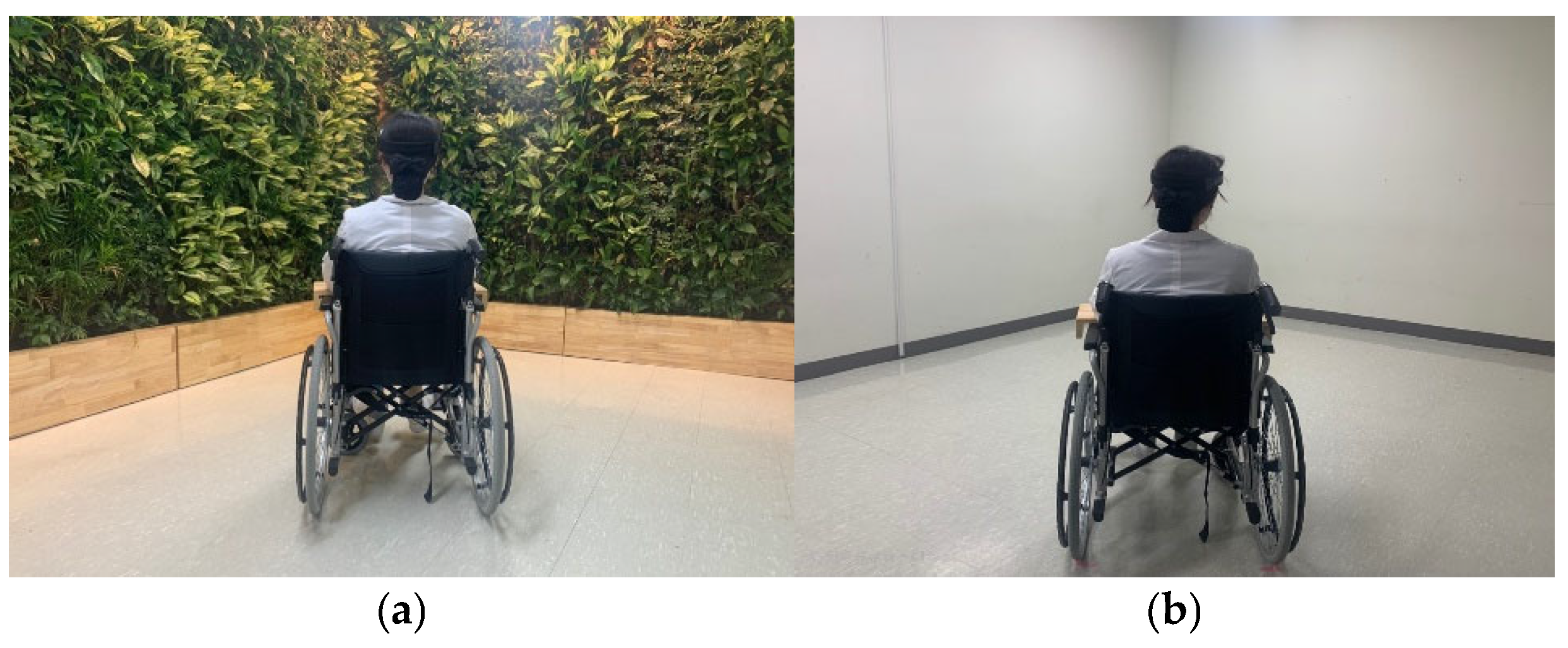

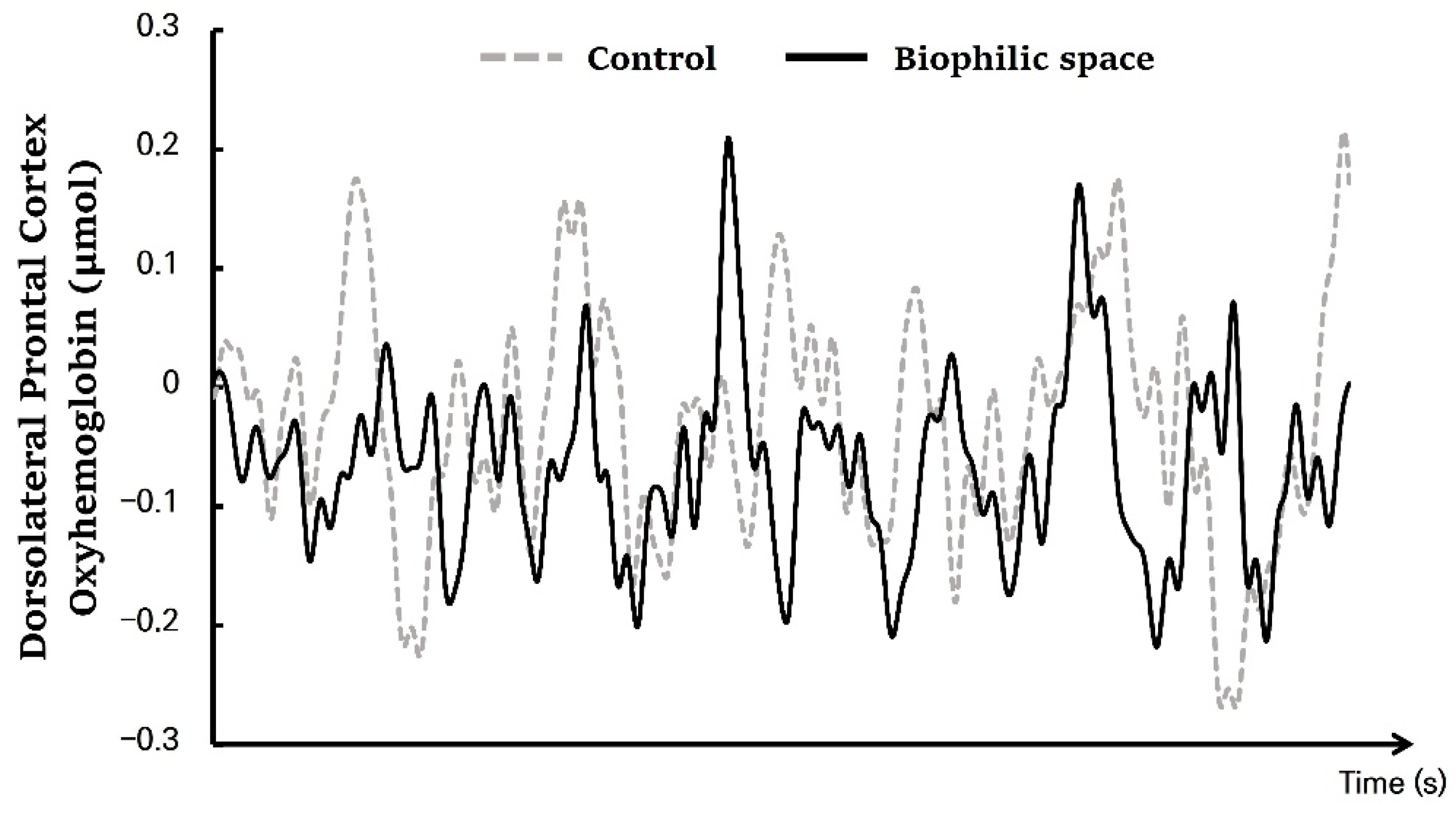
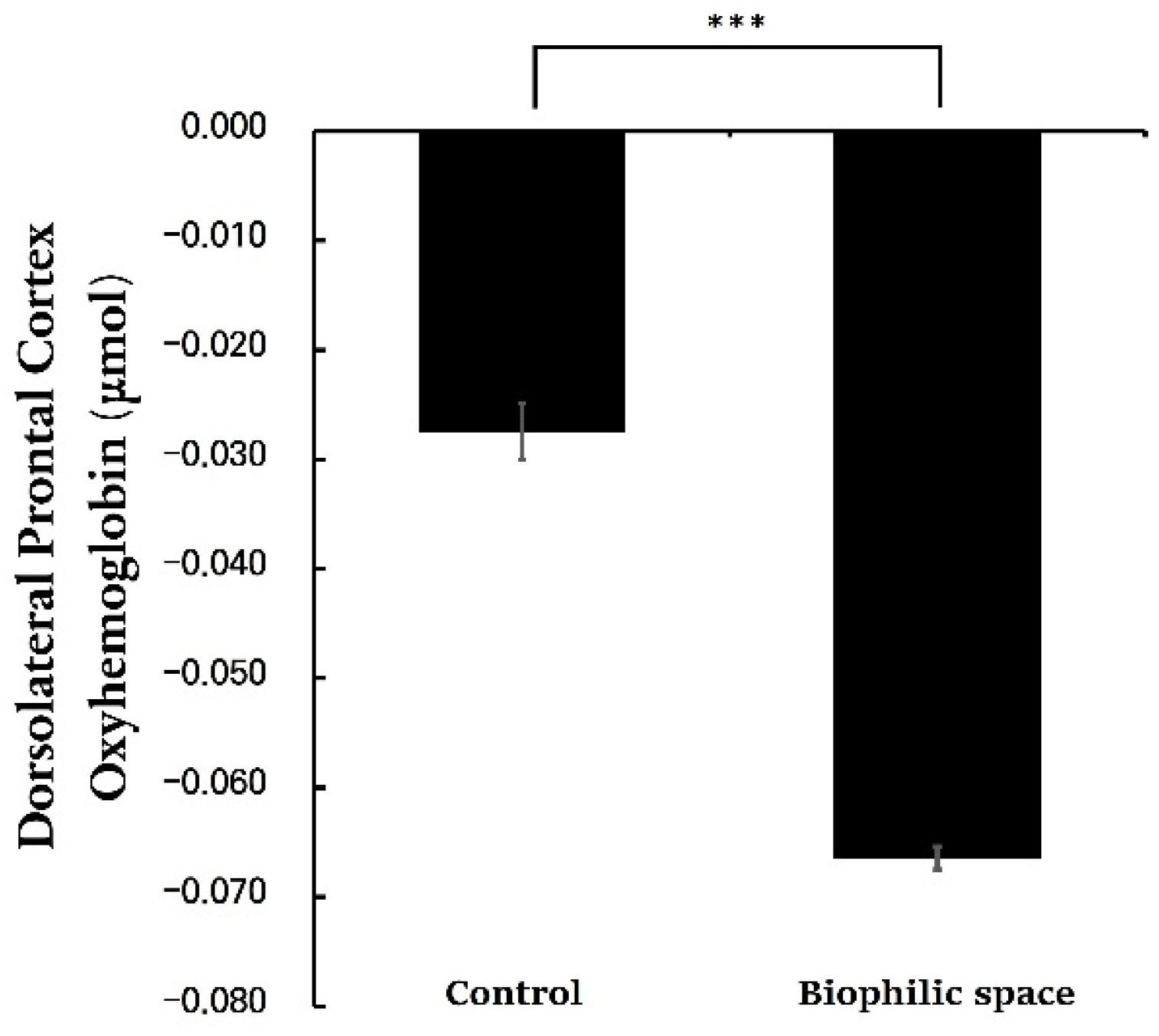
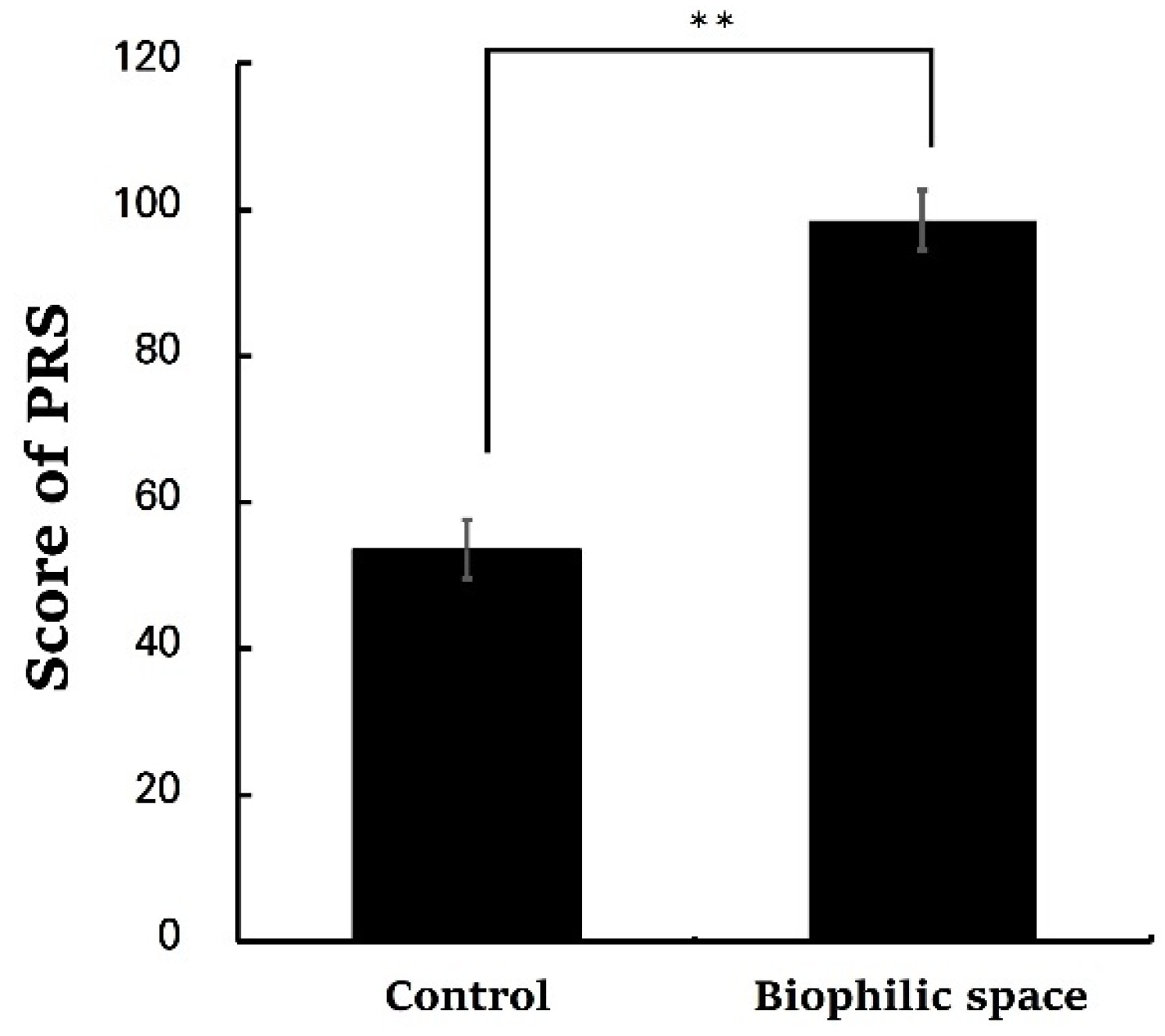
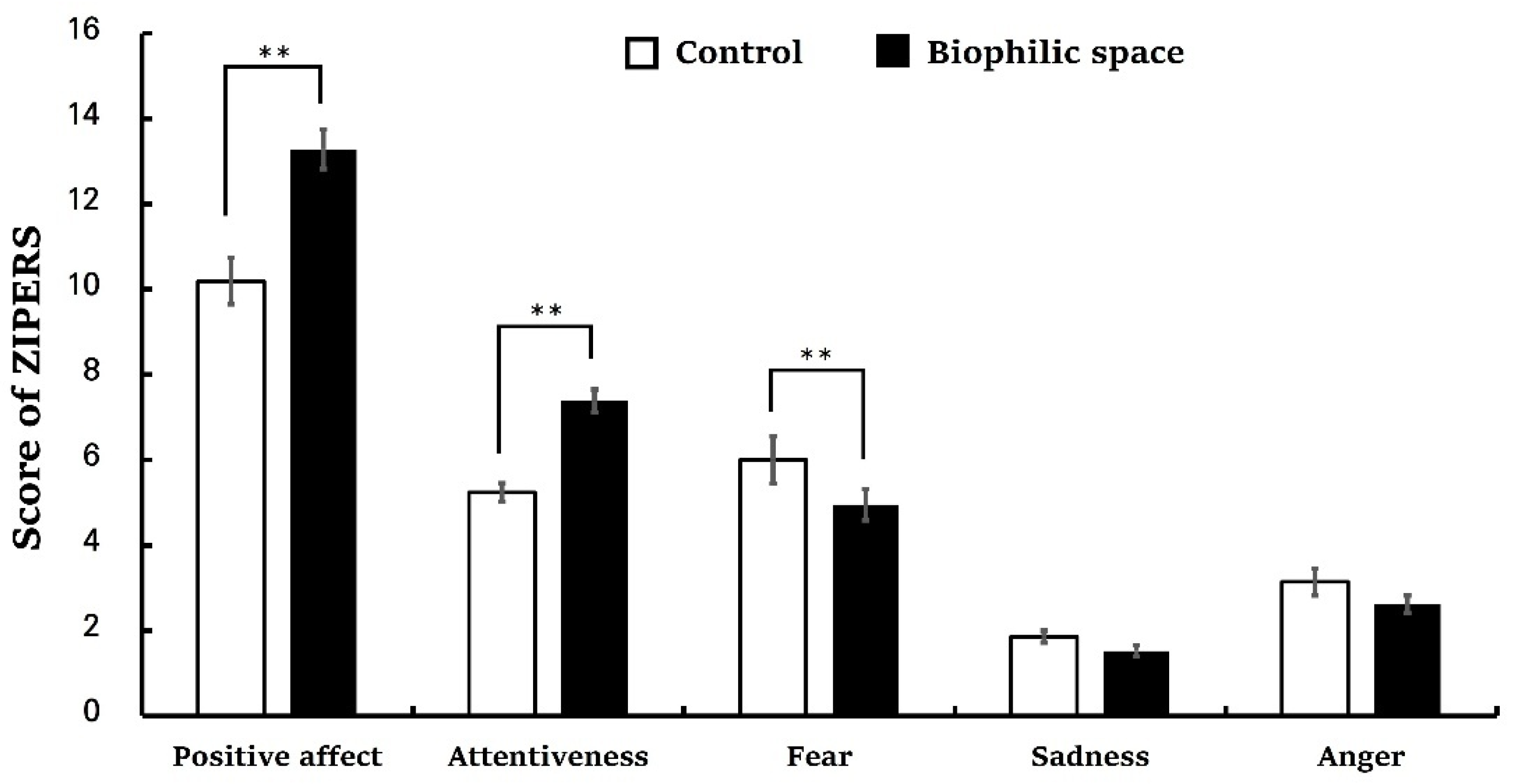
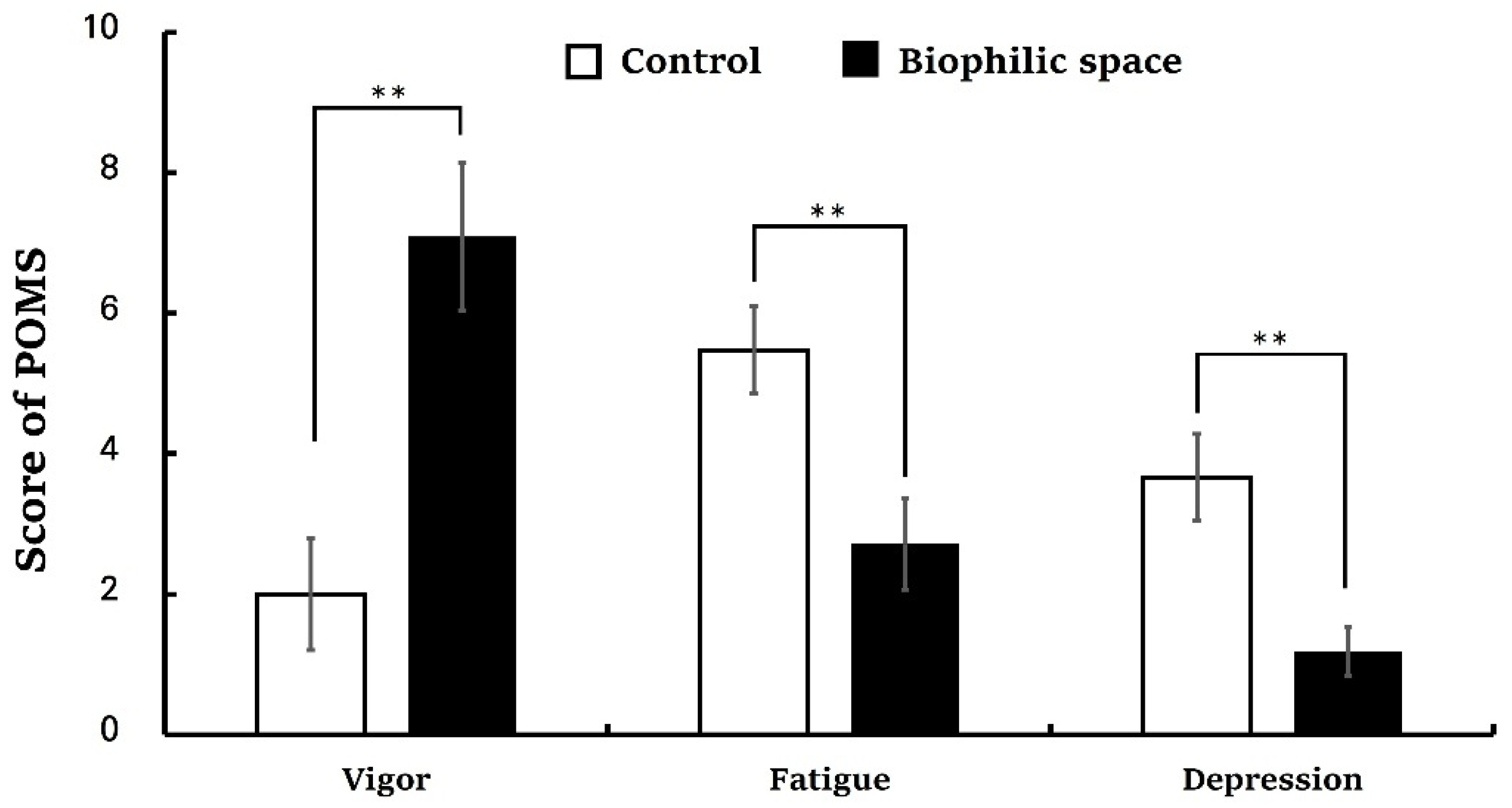
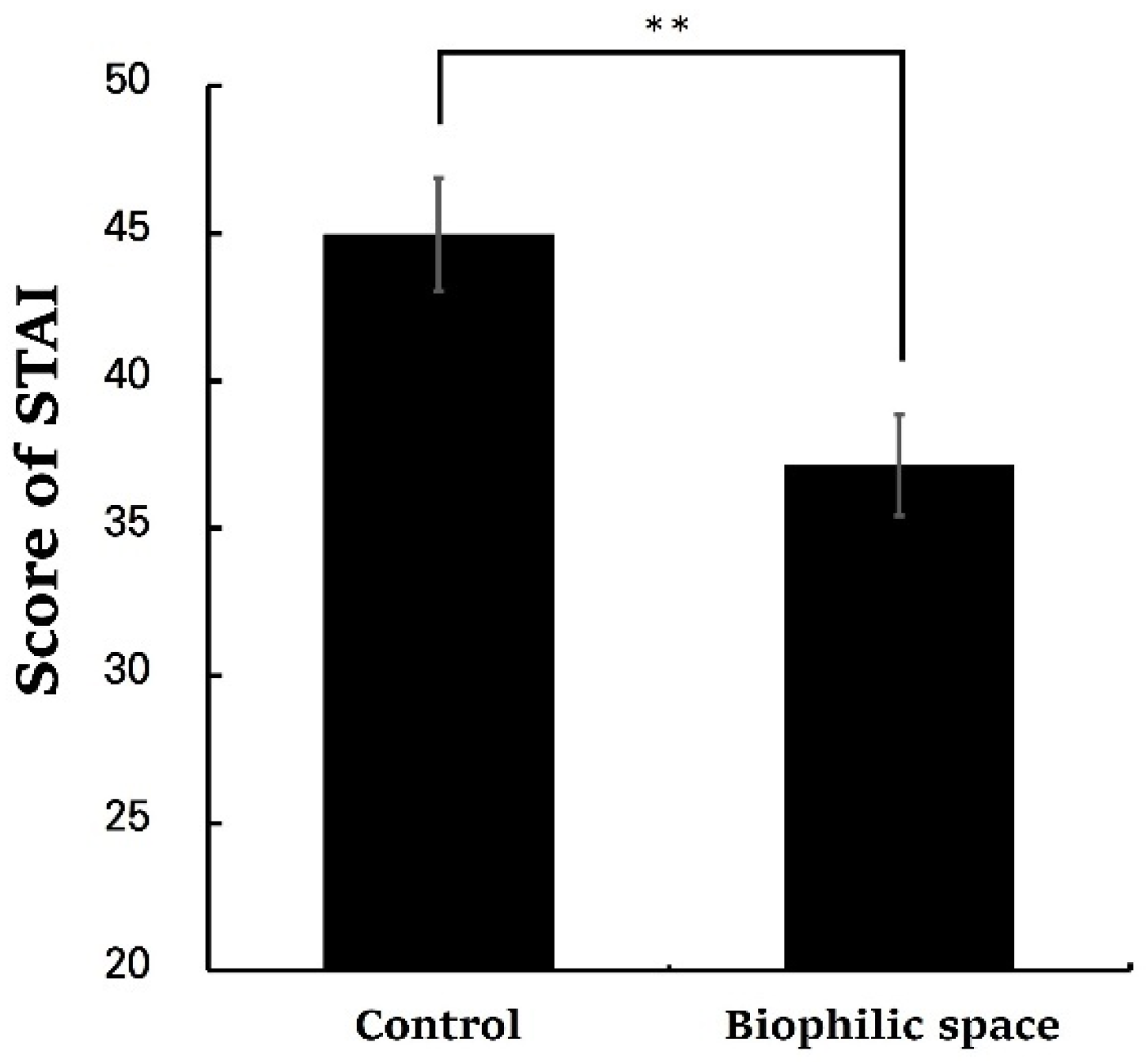
| Scientific Name | Common Name |
|---|---|
| Rhapis excelsa | Lady Palms |
| Davallia mariesii | Squirrels-foot Fern |
| Dracaena sanderiana ‘Victoria’ | Lucky Bamboo |
| Epipremnum aureum ‘Lime’ | Lime Pothos |
| Trachelospermum asiaticum var. variegatum | Variegated Asiatic Jasmine |
| Hedera helix ’Sagittifolia’ | English Ivy |
| Ardisia pusilla | Small Coralberry |
| Ardisia japonica | Marlberry |
| Chamaedorea elegans | Parlor palm |
| Hoya carnosa | Wax plant |
| PFC Region | Sec. | Group | Mean | SE | p |
|---|---|---|---|---|---|
| DLPFC | 0–120 | Control | −0.028 | 0.003 | <0.001 |
| Biophilic Space | −0.053 | 0.001 | |||
| 120–240 | Control | −0.021 | 0.003 | <0.001 | |
| Biophilic Space | −0.087 | 0.002 | |||
| 240–360 | Control | −0.032 | 0.002 | <0.001 | |
| Biophilic Space | −0.055 | 0.003 | |||
| 360–480 | Control | −0.004 | 0.003 | <0.001 | |
| Biophilic Space | −0.047 | 0.003 | |||
| 480–600 | Control | −0.064 | 0.004 | <0.001 | |
| Biophilic Space | − 0.091 | 0.002 |
| Score of PRS | Control | Biophilic Space | p | ||
|---|---|---|---|---|---|
| Mean | SE | Mean | SE | ||
| Being away | 6.62 | 0.96 | 12.24 | 0.80 | <0.01 |
| Fascination | 9.48 | 1.76 | 27.38 | 1.61 | <0.01 |
| Coherence | 25.05 | 1.05 | 29.81 | 1.10 | <0.01 |
| Compatibility | 12.48 | 1.89 | 29.10 | 1.88 | <0.01 |
Disclaimer/Publisher’s Note: The statements, opinions and data contained in all publications are solely those of the individual author(s) and contributor(s) and not of MDPI and/or the editor(s). MDPI and/or the editor(s) disclaim responsibility for any injury to people or property resulting from any ideas, methods, instructions or products referred to in the content. |
© 2025 by the authors. Licensee MDPI, Basel, Switzerland. This article is an open access article distributed under the terms and conditions of the Creative Commons Attribution (CC BY) license (https://creativecommons.org/licenses/by/4.0/).
Share and Cite
Youn, C.; Kang, M.; Lee, J. Biophilic Design and Restorative Effects: A Neuropsychological Study of Healthy Indoor Workspaces in Urban Contexts. Int. J. Environ. Res. Public Health 2025, 22, 1571. https://doi.org/10.3390/ijerph22101571
Youn C, Kang M, Lee J. Biophilic Design and Restorative Effects: A Neuropsychological Study of Healthy Indoor Workspaces in Urban Contexts. International Journal of Environmental Research and Public Health. 2025; 22(10):1571. https://doi.org/10.3390/ijerph22101571
Chicago/Turabian StyleYoun, ChoHye, Minji Kang, and Juyoung Lee. 2025. "Biophilic Design and Restorative Effects: A Neuropsychological Study of Healthy Indoor Workspaces in Urban Contexts" International Journal of Environmental Research and Public Health 22, no. 10: 1571. https://doi.org/10.3390/ijerph22101571
APA StyleYoun, C., Kang, M., & Lee, J. (2025). Biophilic Design and Restorative Effects: A Neuropsychological Study of Healthy Indoor Workspaces in Urban Contexts. International Journal of Environmental Research and Public Health, 22(10), 1571. https://doi.org/10.3390/ijerph22101571






